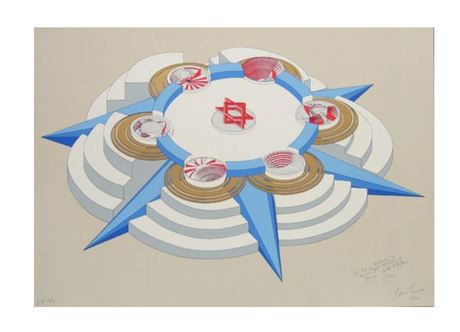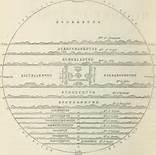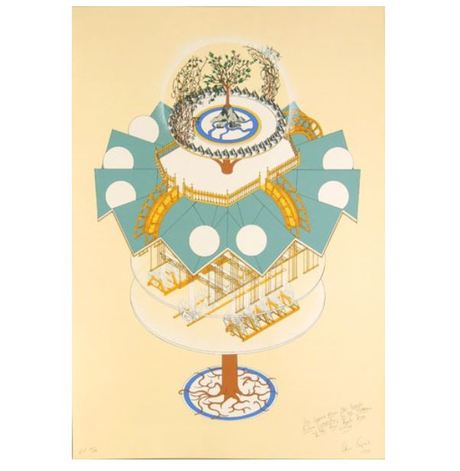Worlds Beneath
Alice Aycock is an American installation artist known for her land art and large-scale sculptures. Aycock received a Bachelors of Arts degree from Douglass College in New Brunswick, New Jersey in 1968. In 1971 she moved to New York where she continued her education under conceptual artist Robert Morris at Hunter College, where she received her Master of the Arts degree.
After Aycock received her Master’s degree, she created her most famous piece, Maze, in 1972. Maze, like many of her works, addresses the body’s relationship to its surrounding by posing exploratory situations for the viewer to interact with. Maze is installed in the farmland near New Kingstown, Pennsylvania. The maze itself is 32 feet in diameter and is made up of five, six-foot tall sections. Alice Aycock reflects on Maze saying,
“Originally, I had hoped to create a moment of absolute panic—when the only thing that mattered was to get out…Like the experience of the highway, I thought of the maze as a sequence of body/eye movements from position to position. The whole cannot be comprehended at once. It can only be remembered as a sequence…I took the relationship between my point of entry and the surrounding land for granted, but often lost my sense of direction when I came back out. From one time to the next, I forgot the interconnections between the pathways and kept rediscovering new sections.”
Obsessed with axial alignment in compasses, Aycock’s interest in the viewer’s connection with the outside world became a prominent focal point in her work. She takes on a new technique with additional pieces such as; Low Building with Dirt Roof (1973), A Simple Network of Underground Wells and Tunnels (1975), and The Islands of the Rose Apple Tree Surrounded by the Oceans of the World for You, Oh My Darling (1987). This technique involved sculpting by cutting out sections of the natural world and replacing it with something man made. Aycock was the only female in the contemporary art world to work in this style at the time. Her status as an artist has provided her opportunities to teach in upper level education settings and her work is recognized and installed internationally.
In lectures, Alice Aycock will often begin by retelling a story written by Jorge Luis Borges. In the story, the author searches for information about his long lost love and in doing so, circuitously stumbles upon a tear in the universe–in which he can suddenly see everything that was, everything that is, and everything that will be. This parable seems to influence many of Aycock’s works but certainly is evoked when looking at “Islands.” The piece is ostensibly inspired by Mount Meru, a cosmic mountain believed to be both the highest and most center point of the universe in eastern mythology. For this reason, the piece lays flat and low to the ground–meant to be experienced from a bird’s eye view in which the spectator can at once see all the world: the center, a sacred peak, expanding outward in intricate patterns of straight and curved lines. Aycock employs contradictions to emphasize this idea of oneness, balance, and totality: the structure is made of stone (industrial, man-made) and yet running water flows through it (a natural, flexible element). From the title, we can infer that the structure itself is the island or individual, surrounded by the ocean, a symbolic tool to convey depth and the mystery that surrounds the questioning individual. The rings that make up the labyrinthine shape evoke the tiers towards heaven or hell present in many schools of religious thought, as well as looking like a topographic rendering of a mountain. The site of the sculpture also feels intentional–hidden in a cove-like section of campus, it has the feel of being out of place (indeed not of this world), put there to be stumbled upon by chance, much like the protagonist in Borges’s story.
While researching the history of Aycock’s piece “The Island…” within the possible inspirations and influences surrounding the creation of it I found a story which takes place over 100 years ago. As stated earlier the piece uses patterns and markings that of which resemble eastern Asian and Indian stylistic approaches. I believe the artist did this with the intent of referring to a riot which took place on September 5, 1907. This event is known as the Bellingham Riots, in which a group of 400-500 local men and women grouped together with the intent of segregating and exiling the immigrated and local East Indian residents from the local workforce waterside barracks. Several Indians were left brutally injured while up 410 were jailed. Soon after most of the East Indian community had absconded the city, then followed by a majority of residents of Chinese, Japanese, and Filipino descent.
I believe the artist intended to use these markings as clear visual representations to shine light on this atrocity. It seems to represent a healthy reminder that every part of the world has bits of injustice and we should look to them as reminders of how not to act and hopefully reduce
that kind of behaviour. It also reminds us that art can be quite political and even though the event did not take place anytime during the creation of the piece it is there to say it is never the wrong time to question and respond to atrocities such as this one.
Tree of Life Fantasy (1991)

The Six Pentacles to Know All Manner of Things–Past and Future (1992)

The World Above/The World Below According to the Pattern of the Rose Apple Tree (1990)
Map of Jambudvipa
https://en.wikipedia.org/wiki/Jambudvipa#/media/File:Map_of_Jambudvipa_Indian_Hindu_Cosmology.jpg
Artist Statement:
After being exposed to Alice Aycock’s sculpture, “The Islands of the Rose Apple Tree Surrounded by the Oceans of the World for You, Oh My Darling” (1987), we began an existential approach to expressing our emotions and creativity upon witnessing the mystique like sculpture. After looking at some Aycock’s other pieces It is Apparent that her use of physical representations in the sculpture is nodded to her drawings from the early 90’s: “Tree of Life Fantasy” and “The World Above/The World Below According to the Pattern of the Rose Apple Tree.” Her pieces are built around ritual-esque geometric shapes that meld with theological figures and motions to represent the environments that inspired it. This creates an opportunity for a viewer to interact with thoughts about nature and analyze an experience between one’s self and their natural habitat. Aycock’s representation of the universe and the point of the self in it stems from poems she read by Jorge Luis Borges. Audio recites Jorge Luis Borges’ “Compass.” At first glance, the sculpture resembles a kind of maze. it opens up emotions of fear and entrapment, however, it also creates this desire for freedom. freedom from one’s environment, stress, and self. Even though the sculpture is oddly placed in relation to its location it is still a memorable sculpture with a rich history and atmosphere which adds to the beauty that is Western.
Group: Chris Butcher ( song written and performed by)
Ivy Lenane (research and writing by)
Grace Shepersky ( Orignail drawing created by)



Leave a Reply